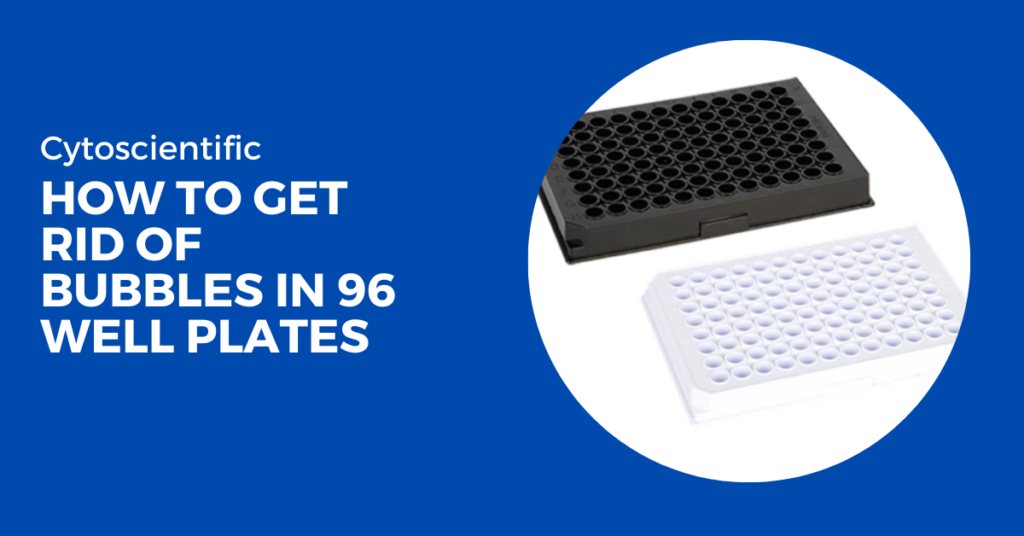When working with 96-well plates, one common issue you may encounter is the formation of bubbles in the wells. These bubbles can interfere with experiments, affect readings, and compromise results. Fortunately, there are several ways to get rid of bubbles in 96-well plates. Here’s a step-by-step guide to help you achieve bubble-free wells.
Use Proper Pipetting Technique
Remember the following guidelines to minimize bubble formation while using a pipette:
- Pre-wet the Pipette Tip: Before starting your experiment, aspirate and dispense the liquid a few times to pre-wet the pipette tip. This promotes a more even flow and prevents bubble formation
- Dispense Slowly: Release the liquid at a slow, steady pace. Rapid dispensing can create turbulence, leading to the formation of bubbles. A controlled flow reduces the likelihood of introducing air into the liquid.
- Angle the Pipette Tip: Hold the pipette tip at a slight angle when dispensing into the well. Allowing the liquid to run down the well wall minimizes disturbance and prevents bubble formation.
- Avoid Pipette Over-Immersion: Do not immerse the pipette tip too deeply in the liquid, as this can draw in air and form bubbles. Keep the tip just below the liquid surface.
Tap the Plate Gently
Centrifuge the Plate
Using a centrifuge is an effective way to eliminate stubborn bubbles, especially if they are trapped at the bottom of the wells. Here’s how:
- Set the Correct Speed: Place the 96-well plate in a plate centrifuge and spin it at a low speed (around 1000-1500 RPM) for a short duration (30 seconds to 1 minute). This will help any trapped bubbles move to the top and burst.
- Check for Compatibility: Ensure that the speed and duration settings are compatible with your plate material and the contents. Excessive force could damage delicate samples or cause spills.
Inspect Under Light
Use a Plate Sealer Carefully
If your experiment requires a plate sealer, make sure to apply it carefully. Applying the sealer from one end of the plate to the other in a smooth, even motion can help you avoid uneven sealing or trapping air while sealing, which can lead to bubbles.
Use Bubble Removal Tools
here are specific tools designed to remove bubbles from microplates. These tools, such as bubble poppers or bubble scrapers, can be gently used across the surface of the plate to eliminate bubbles without affecting the liquid volume or sample integrity.
Re-Pipette if Necessary
If bubbles persist despite using these methods, consider re-pipetting the liquid:
Aspirate Carefully: Use a pipette to carefully aspirate the liquid from the well without disturbing it. This method allows you to remove bubbles without introducing new ones.
Dispense Gently: Re-dispense the liquid into the well slowly and at an angle to prevent bubble formation.
Use Surfactants if Compatible
Some experiments require adding a small amount of surfactant to reduce surface tension, which can help prevent bubble formation. Ensure that the surfactant is compatible with your reagents and will not interfere with your results.
Maintain Temperature Consistency
Remember the following information: Temperature fluctuations can cause bubbles to form due to changes in gas solubility. To prevent this:
- Equilibrate Samples and Plates: Make sure that all reagents and plates are at room temperature before use. Sudden temperature changes can lead to gas bubbles forming in the wells.
- Avoid Drafts: Perform experiments in a controlled environment with stable temperature and airflow to reduce the chance of bubbles forming due to rapid temperature shifts.
Use Proper Filling Volumes
Conclusion
Following the strategies outlined in this post, such as using correct pipetting techniques, centrifuging, inspecting under light, and applying plate sealers carefully, can effectively minimize or eliminate bubbles in 96-well plates, a common challenge that can affect the accuracy and reliability of your results. Remember, maintaining bubble-free plates and ensuring consistent, reliable experimental outcomes requires attention to detail and proper technique. Implement these methods in your lab practice to achieve more accurate and dependable results every time.
Here at CytoScientific, we offer exceptional 96 well plates designed to streamline your research and deliver exceptional results. We Offers various volumes of 96-Well PCR Plate (0.1ml,0.2ml) are available in no skirt, semi skirt and full skirt form. Unlock the full potential of your PCR experiments with our high-performance PCR Plates. Browse our selection and find the perfect fit for your research needs today.

